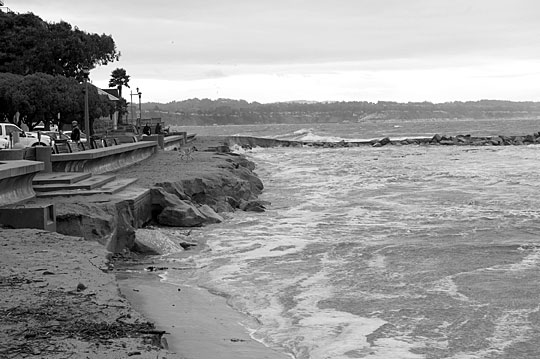Resilient Habitats Campaign will address effects of sea level rise
April 2011

Capitola Beach eroded away by king tides event in February 2011. Is this a glimpse of sea level rise?
Photo: Susan Hillyard
Sierra Club California has recently launched the California Coast Resilient Habitats Campaign to address the effects of climate change on the state’s coastal regions. The campaign will focus on protecting, connecting, and restoring California’s coastal habitats in order to allow our wildlife to adapt to changing conditions. The most urgent issue facing Central Coast residents is the rising sea level (see maps: www.pacinst.org/reports/sea_level_rise/maps/). Even if we are able to successfully implement CO2 reduction measures, sea level rise has already been set in motion. We must now turn our attention to ways to adapt to this inevitability.
Addressing sea level rise
The initial focus of the California Coast Resilient Habitats Campaign will be to foster the best planning and development policies possible at the state level through the Ocean Protection Council, California Coastal Commission, and Bay Conservation and Development Commission. These policies will influence State activities and work their way to the local level, where most land use decisions are made. In local communities, the Campaign will show people how to protect shorelines using natural systems that protect and expand habitat. The campaign will be looking for areas that are ripe for positive shoreline protection policies to focus its efforts.
Seawalls: the wrong answer
When the sea threatens property, the first response is often to build a seawall. Seawalls are both expensive to build and maintain, and destructive to habitats and beaches. The Pacific Institute estimates it would cost $14 billion to armor California’s coast against sea level rise and $1.4 billion annually in maintenance costs. Furthermore, seawalls cause the loss of beaches in front of and below the wall, create beach access issues, and do not support half the diversity of marine life that natural rocky areas support.
We have options. We can stop placing people and businesses in harm’s way, by not allowing development in projected flood plains. We can build natural habitats that act as wave breaks to lessen beach erosion, such as kelp forests and oyster beds. We can build dunes and establish vegetation barriers to protect shorelines. We can allow for the expansion of wetlands to assure that these important ecosystems don’t drown and to provide flood buffers. And we can make choices to concede to nature and plan retreat from the shore, which is often the most cost effective and safest option.
Growing the campaign
As the campaign is able to fundraise and grow, it intends to expand into key conservation area protection (marine sanctuaries, wildlife corridors, wetlands preservation and expansion), updating the State Wildlife Action Plan, and engage in protection of the upland watershed to encompass issues such as water quality, inflow, and fish barriers.
Volunteers sought
Volunteers are needed to explore the potential for positive shoreline protection polices in local communities and to educate public officials, Sierra Club members, and community members on the use of natural systems to protect the shoreline and wildlife habitats. If you are interested in getting involved, you are encouraged to call Lesli at 916-557-1100x105. Please come and make a difference: Conserve & Protect California’s Coast!
< back to all issues


 Capitola Beach eroded away by king tides event in February 2011. Is this a glimpse of sea level rise?
Capitola Beach eroded away by king tides event in February 2011. Is this a glimpse of sea level rise?